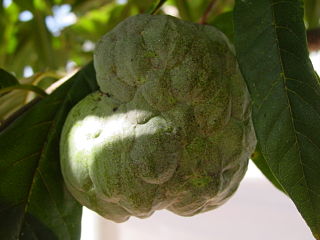
The Annonaceae are a family of flowering plants consisting of trees, shrubs, or rarely lianas commonly known as the custard apple family or soursop family. With 108 accepted genera and about 2400 known species, it is the largest family in the Magnoliales. Several genera produce edible fruit, most notably Annona, Anonidium, Asimina, Rollinia, and Uvaria. Its type genus is Annona. The family is concentrated in the tropics, with few species found in temperate regions. About 900 species are Neotropical, 450 are Afrotropical, and the remaining are Indomalayan.

Annona or Anona is a genus of flowering plants in the pawpaw/sugar apple family, Annonaceae. It is the second largest genus in the family after Guatteria, containing approximately 166 species of mostly Neotropical and Afrotropical trees and shrubs.

Eupomatia is a genus of three species of plants in the ancient family Eupomatiaceae, and is the sole genus in the family. Eupomatiaceae is recognised by most taxonomists and classified in the plant order Magnoliales. The three described species are shrubs or small trees, native to the rainforests and humid eucalypt forests of eastern Australia and New Guinea. The type species Eupomatia laurina was described in 1814 by Robert Brown.

Monodora myristica, the calabash nutmeg or African nutmeg, is a tropical tree of the family Annonaceae or custard apple family of flowering plants. It is native to tropical Africa from Sierra Leone in the west to Tanzania. In former times, its seeds were widely sold as an inexpensive nutmeg substitute. This is now less common outside its region of production. Other names of calabash nutmeg include Jamaican nutmeg, ehuru, ariwo, awerewa, ehiri, airama, African orchid nutmeg, muscadier de Calabash and lubushi.
Hexalobus salicifolius is a species of flowering plant in the family Annonaceae. It is found in Cameroon, Ivory Coast, Gabon, and the Republic of the Congo. Local common names include oouè, owoé, and owui.
Monocyclanthus is a monotypic genus of flowering plants in the family Annonaceae containing the single species Monocyclanthus vignei. It is native to Ghana and Liberia. It is a rare plant of the understory of wet evergreen forest habitat.

Popowia is a genus of flowering plants in the family Annonaceae. There are about 50 species distributed in tropical Asia and Africa and in Oceania.

Uvaria is a genus of flowering plants in the family Annonaceae. The generic name uvaria is derived from the Latin uva meaning grape, likely because the edible fruit of some species in the genus resemble grapes.
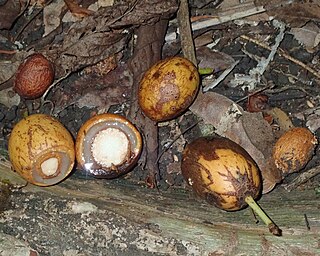
Xylopia vielana is a tree species described by Pierre; it is included in the genus Xylopia and family Annonaceae. No subspecies are listed in the Catalogue of Life.
Uvariopsis zenkeri Engl. is a species of flowering shrub in the family Annonaceae endemic to Cameroon and the Central African Republic.
Hexalobus bussei is a species of plant in the family Annonaceae. It is native to Cameroon. Ludwig Diels, the German botanist who first formally described the species, named it after another German botanist, Walter Busse, who collected the sample that Diels examined.

Hexalobus crispiflorus is a species of plant in the family Annonaceae. It is native to Angola, Benin, Cameroon, Central African Republic, Congo, DR Congo, Gabon, Ghana, Guinea, Guinea-Bissau, Ivory Coast, Liberia, Nigeria, Senegal, Sierra Leone, Sudan, Togo and Zaire. Achille Richard, the French botanist who first formally described the species, named it after its wavy petals of its flowers.

Hexalobus monopetalus is a species of plant in the family Annonaceae with the common name baboon's breakfast. It is native to Angola, Benin, Botswana, Burkina Faso, Cameroon, Central African Republic, Chad, Gambia, Ghana, Guinea, Guinea-Bissau, Ivory Coast, Liberia, Malawi, Mali, Mozambique, Namibia, Niger, Nigeria, Senegal, South Africa, Sudan, Tanzania, Togo, Uganda, Zambia, Zaire and Zimbabwe. Achille Richard, the French botanist who first formally described the species, using the basionym Uvaria monopetala, named it after its petals which are fused at their base.
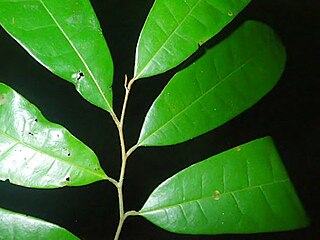
Meiocarpidium lepidotum is a species of plant in the family Annonaceae. It is native to Cameroon, The Central African Republic, The Republic of the Congo, and Gabon. Daniel Oliver, the English botanist who first formally described the species using the basionym Unona lepidota, named it after rust-colored, shiny scales on its branchlets, the underside of its leaves and its buds.
Monodora crispata is a species of plant in the family Annonaceae. It is native to Cameroon, Equatorial Guinea, Gabon, Ghana, Guinea, Ivory Coast, Liberia, Nigeria, and Sierra Leone. Heinrich Gustav Adolf Engler, the German botanist who first formally described the species, named it after its curled petal margins.
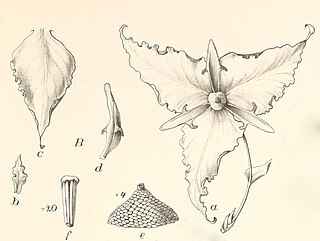
Monodora minor is a species of plant in the family Annonaceae. It is native to Mozambique and Tanzania. Heinrich Gustav Adolf Engler and Ludwig Diels, the German botanists who first formally described the species, do not explicitly explain the specific epithet but it is among the smaller members of the genus which includes species that reach heights of 30-40 meters.

Monodora stenopetala is a species of plant in the family Annonaceae. It is native to Malawi and Mozambique. Daniel Oliver, the English botanist who first formally described the species, named it after its narrow petals.
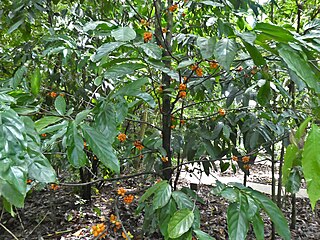
Pseuduvaria froggattii is a rare species of tree which is restricted to a very small part of northeastern Queensland, Australia. It is a member of the custard apple and soursop family Annonaceae, and was first described in 1887. Despite the small range its status considered to be least concern.

Uvariastrum hexaloboides is a species of plant in the Annonaceae family. It is native to Tanzania, Zambia and Zaire. Robert Elias Fries, the botanist who first formally described the species using the basionym Uvaria hexaloboides, named it after a different species Hexalobus monopetalus which he thought its flowers and vegetative parts resembled.














